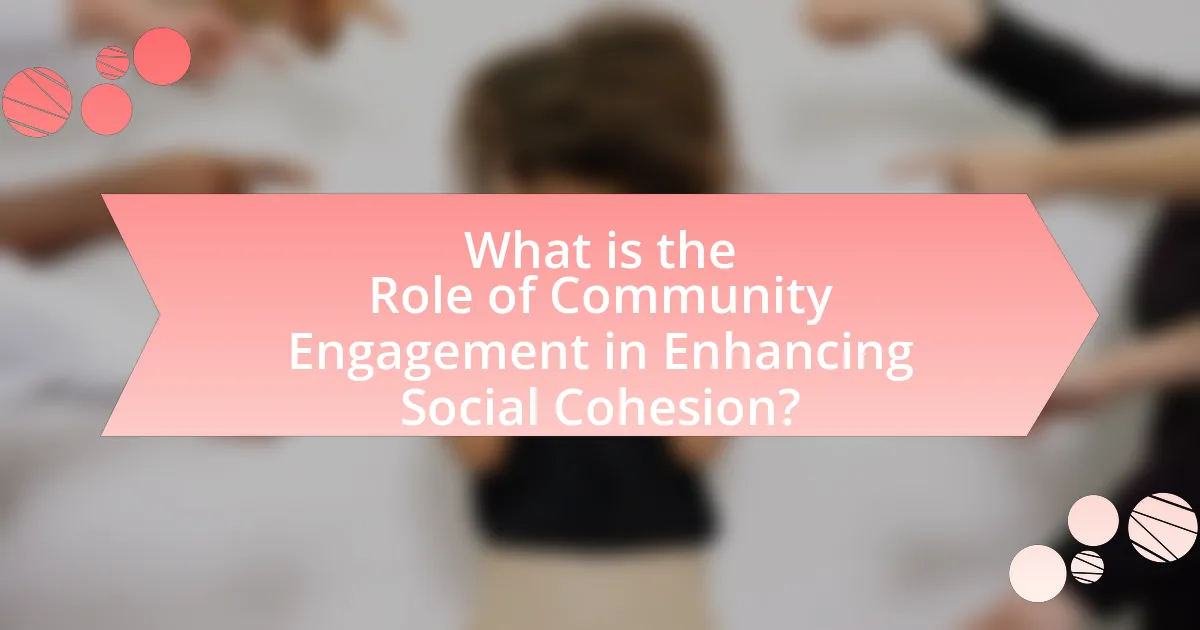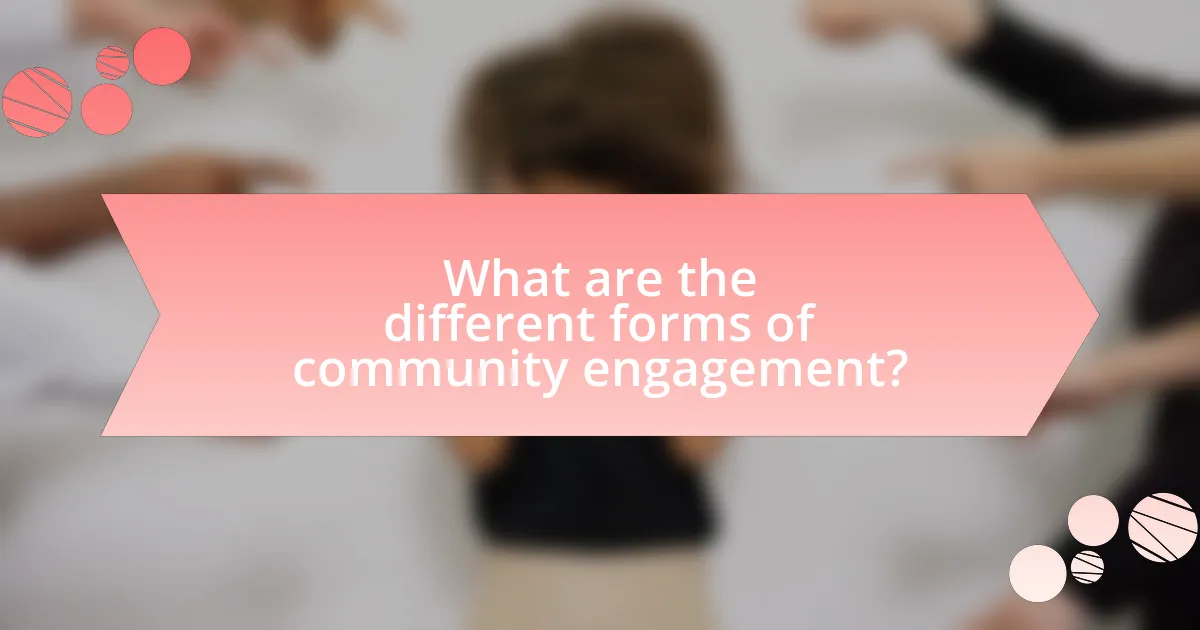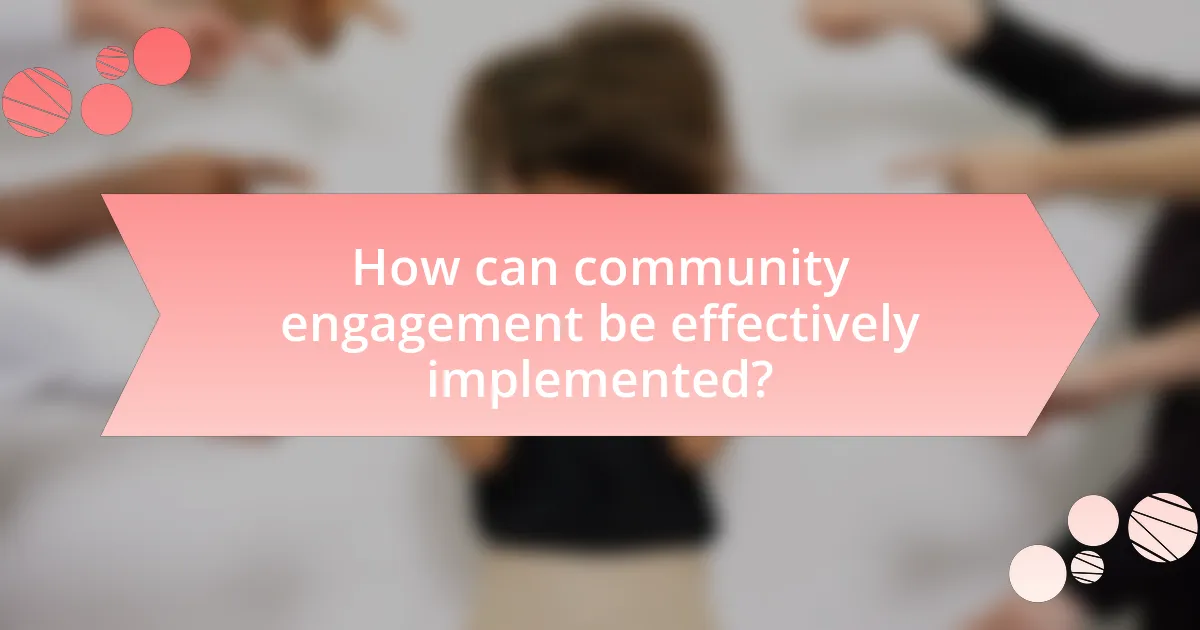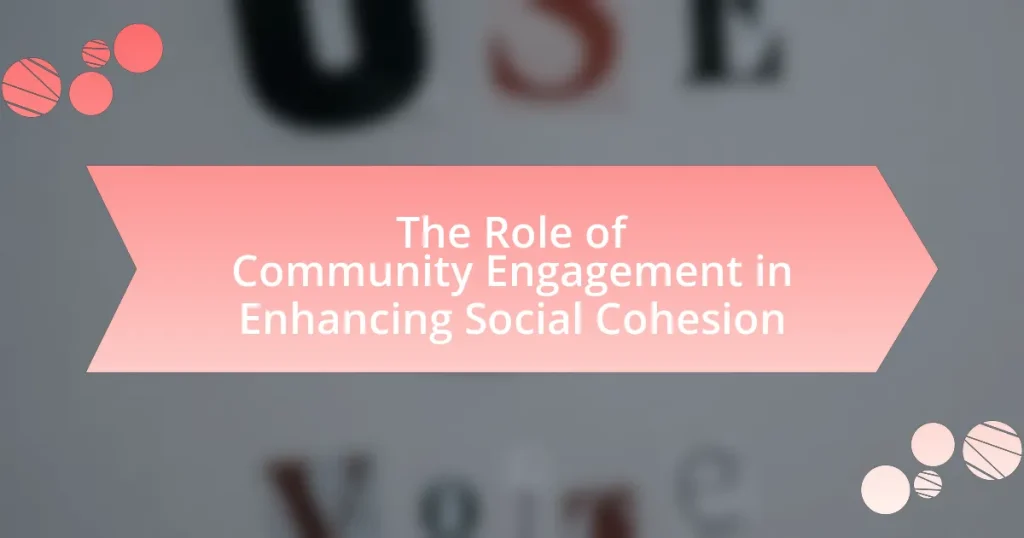Community engagement is a vital component in enhancing social cohesion within communities. This article explores how active participation fosters relationships, trust, and a sense of belonging among diverse groups, leading to lower crime rates and improved mental health outcomes. Key elements of community engagement, such as participation, collaboration, communication, and empowerment, are discussed, along with various forms of engagement like volunteerism and participatory decision-making. The article also addresses the challenges communities face in engaging residents and offers strategies to overcome these barriers, highlighting the importance of social cohesion for community resilience and well-being. Successful examples of community engagement initiatives illustrate the tangible benefits of fostering inclusivity and collaboration.

What is the Role of Community Engagement in Enhancing Social Cohesion?
Community engagement plays a crucial role in enhancing social cohesion by fostering relationships and trust among diverse groups within a community. When individuals actively participate in community activities, they develop a sense of belonging and shared identity, which strengthens social bonds. Research indicates that communities with high levels of engagement experience lower crime rates and improved mental health outcomes, as seen in the study “The Role of Community Engagement in Building Social Cohesion” by the University of Queensland, which highlights that engaged communities are more resilient and better equipped to address social challenges. Thus, community engagement not only promotes inclusivity but also contributes to the overall stability and harmony of society.
How does community engagement contribute to social cohesion?
Community engagement fosters social cohesion by promoting interaction, understanding, and collaboration among diverse groups within a community. When individuals participate in community activities, they build relationships and trust, which are essential for a cohesive society. Research indicates that communities with higher levels of engagement experience lower crime rates and increased civic participation, as seen in studies conducted by the National Institute of Justice, which found that engaged communities are more resilient and better equipped to address social issues. This interaction not only enhances mutual respect but also encourages collective problem-solving, further solidifying social bonds.
What are the key elements of community engagement?
The key elements of community engagement include participation, collaboration, communication, and empowerment. Participation involves actively involving community members in decision-making processes, ensuring their voices are heard and valued. Collaboration refers to building partnerships among various stakeholders, including local organizations, government entities, and residents, to address community needs collectively. Effective communication is essential for sharing information, fostering transparency, and building trust within the community. Empowerment focuses on equipping individuals with the skills and resources necessary to take initiative and lead community efforts. These elements are supported by research indicating that communities with high levels of engagement experience improved social cohesion and resilience.
How do these elements foster social connections?
Community engagement fosters social connections by creating opportunities for individuals to interact, collaborate, and build relationships within their communities. These interactions often occur through organized events, volunteer activities, and local initiatives that encourage participation and shared experiences. Research indicates that communities with higher levels of engagement report stronger social ties and a greater sense of belonging, as evidenced by a study published in the Journal of Community Psychology, which found that active participation in community activities significantly enhances social networks and trust among residents.
Why is social cohesion important for communities?
Social cohesion is important for communities because it fosters trust, cooperation, and a sense of belonging among residents. When individuals feel connected to one another, they are more likely to engage in collective actions that benefit the community, such as volunteering, participating in local governance, and supporting local businesses. Research indicates that communities with high social cohesion experience lower crime rates and improved mental health outcomes, as individuals are more likely to support each other in times of need. For instance, a study published in the Journal of Community Psychology found that neighborhoods with strong social ties reported higher levels of community safety and well-being.
What are the benefits of a socially cohesive community?
A socially cohesive community fosters trust, collaboration, and mutual support among its members, leading to enhanced well-being and resilience. Research indicates that such communities experience lower crime rates, improved mental health outcomes, and greater civic participation. For instance, a study by the National Institute of Justice found that neighborhoods with strong social ties report 50% lower crime rates compared to those with weak connections. Additionally, cohesive communities often have better access to resources and services, as residents are more likely to work together to address common challenges. This collaborative spirit not only strengthens social bonds but also promotes economic stability and growth within the community.
How does social cohesion impact community resilience?
Social cohesion significantly enhances community resilience by fostering trust, collaboration, and mutual support among community members. When individuals feel connected and engaged, they are more likely to work together during crises, share resources, and provide emotional support, which are critical components in overcoming challenges. Research indicates that communities with high social cohesion can recover more quickly from disasters; for instance, a study by Aldrich (2012) in “Building Resilience: Social Capital in Post-Disaster Recovery” found that neighborhoods with strong social ties experienced faster recovery rates after natural disasters compared to those with weaker connections. This demonstrates that social cohesion not only strengthens interpersonal relationships but also equips communities with the necessary tools to adapt and thrive in the face of adversity.

What are the different forms of community engagement?
Community engagement takes various forms, including volunteerism, participatory planning, community organizing, and collaborative governance. Volunteerism involves individuals dedicating their time and skills to support community initiatives, which fosters a sense of belonging and responsibility. Participatory planning allows community members to actively contribute to decision-making processes regarding local development, ensuring that diverse perspectives are considered. Community organizing focuses on mobilizing residents to address shared concerns and advocate for social change, enhancing collective efficacy. Collaborative governance involves partnerships between government entities and community organizations to co-create policies and programs, promoting transparency and trust. Each of these forms contributes to social cohesion by building relationships, empowering individuals, and fostering a sense of community ownership.
How do various engagement strategies differ?
Various engagement strategies differ primarily in their methods of interaction and the target audiences they address. For instance, direct engagement strategies, such as community meetings and workshops, focus on face-to-face interactions to foster personal connections and immediate feedback, while digital engagement strategies, like social media campaigns and online surveys, leverage technology to reach a broader audience quickly and efficiently. Research indicates that direct engagement can lead to deeper relationships and trust within communities, as evidenced by a study from the National Civic League, which found that communities with higher levels of face-to-face engagement reported increased social cohesion and collaboration. In contrast, digital strategies can enhance participation from diverse demographics, as shown in a Pew Research Center report highlighting that online platforms can engage younger populations who may be less likely to attend in-person events. Thus, the effectiveness of each strategy varies based on context, goals, and the demographics of the community involved.
What role do volunteer programs play in community engagement?
Volunteer programs serve as a vital mechanism for fostering community engagement by connecting individuals to local initiatives and encouraging active participation. These programs enhance social cohesion by promoting collaboration among diverse community members, which leads to stronger relationships and a sense of belonging. Research indicates that communities with robust volunteer programs experience increased civic participation, improved trust among residents, and greater overall satisfaction with community life. For instance, a study by the Corporation for National and Community Service found that volunteering can lead to a 27% increase in social connectedness, demonstrating the significant impact of volunteerism on community engagement.
How do participatory decision-making processes enhance engagement?
Participatory decision-making processes enhance engagement by actively involving individuals in the decision-making activities that affect their lives. This involvement fosters a sense of ownership and responsibility among participants, leading to increased motivation and commitment to the outcomes. Research indicates that when community members contribute their perspectives and expertise, they are more likely to feel valued and invested in the process, which enhances their overall engagement. For example, a study by the International Association for Public Participation found that communities with higher levels of participatory engagement reported greater satisfaction with local governance and stronger social ties, demonstrating the positive impact of such processes on community cohesion.
What challenges do communities face in engaging residents?
Communities face several challenges in engaging residents, including lack of trust, limited resources, and diverse interests. Lack of trust can stem from past negative experiences with local authorities or perceived ineffectiveness, leading residents to disengage. Limited resources, such as funding and manpower, hinder the ability to organize events or outreach programs that foster engagement. Additionally, diverse interests among residents can create difficulties in finding common ground, making it challenging to develop initiatives that appeal to a broad audience. These factors collectively impede effective community engagement and can result in lower participation rates in community activities.
How can barriers to engagement be identified?
Barriers to engagement can be identified through surveys, interviews, and focus groups that assess community members’ perceptions and experiences. These methods provide direct feedback on obstacles such as lack of awareness, perceived irrelevance of initiatives, or previous negative experiences with engagement efforts. Research indicates that understanding these barriers is crucial; for instance, a study by the National Civic League found that communities with regular feedback mechanisms are 30% more likely to successfully engage residents.
What strategies can overcome these challenges?
Strategies to overcome challenges in community engagement include fostering inclusive participation, enhancing communication channels, and building partnerships with local organizations. Inclusive participation ensures that diverse voices are heard, which can be achieved through targeted outreach efforts that engage underrepresented groups. Enhancing communication channels, such as utilizing social media and community forums, facilitates information sharing and encourages dialogue among community members. Building partnerships with local organizations leverages existing resources and expertise, creating a collaborative environment that strengthens social cohesion. These strategies are supported by research indicating that communities with high levels of engagement report greater social trust and cohesion, as evidenced by studies conducted by the National Civic League, which highlight the positive impact of community involvement on social networks and collective efficacy.

How can community engagement be effectively implemented?
Community engagement can be effectively implemented through structured participation, transparent communication, and collaborative decision-making. Structured participation involves creating platforms for community members to voice their opinions and contribute to local initiatives, which fosters a sense of ownership and responsibility. Transparent communication ensures that information flows freely between community leaders and residents, building trust and encouraging active involvement. Collaborative decision-making allows community members to work alongside local authorities to address issues, leading to solutions that reflect the community’s needs and values. Research by the National Civic League highlights that communities with high levels of engagement report increased social cohesion and improved public trust in local governance.
What best practices should be followed for successful engagement?
Successful engagement requires active listening, clear communication, and inclusive participation. Active listening ensures that community members feel heard and valued, fostering trust and openness. Clear communication involves sharing information transparently and regularly, which helps to align expectations and reduce misunderstandings. Inclusive participation means actively involving diverse community members in decision-making processes, which enhances representation and strengthens social cohesion. Research shows that communities with high levels of engagement experience improved social ties and collective efficacy, as evidenced by studies conducted by the National Civic League, which highlight the positive correlation between community involvement and social outcomes.
How can communities measure the effectiveness of their engagement efforts?
Communities can measure the effectiveness of their engagement efforts through surveys, participation rates, and feedback mechanisms. Surveys can quantify community satisfaction and perceived impact, while participation rates indicate the level of involvement in engagement activities. Feedback mechanisms, such as focus groups or community forums, provide qualitative insights into the community’s views on engagement initiatives. For instance, a study by the National Civic League found that communities with higher participation rates in engagement activities reported increased social cohesion and trust among residents, demonstrating a direct correlation between engagement efforts and community outcomes.
What role does technology play in enhancing community engagement?
Technology plays a crucial role in enhancing community engagement by facilitating communication, collaboration, and access to information. Digital platforms, such as social media and community apps, enable residents to connect, share ideas, and organize events, thereby fostering a sense of belonging and participation. For instance, a study by the Pew Research Center found that 69% of adults in the U.S. use social media, which serves as a vital tool for local organizations to mobilize community members around initiatives and issues. Additionally, technology provides tools for feedback and surveys, allowing communities to voice their opinions and influence decision-making processes, further strengthening civic involvement.
What are some successful examples of community engagement initiatives?
Successful examples of community engagement initiatives include the “Neighborhood Watch” programs, which have effectively reduced crime rates by fostering collaboration between residents and local law enforcement. In cities like San Diego, these programs have led to a 20% decrease in property crimes over five years, demonstrating the power of community involvement in enhancing safety and social cohesion. Another example is the “Community Gardening” initiative in Detroit, where residents transformed vacant lots into productive gardens, improving local food access and strengthening community ties. This initiative has resulted in over 600 community gardens, promoting not only food security but also social interaction among diverse groups. Additionally, the “Participatory Budgeting” process in New York City allows residents to directly influence budget decisions, leading to increased civic engagement and a reported 80% satisfaction rate among participants. These initiatives illustrate how structured community engagement can lead to tangible improvements in social cohesion and community well-being.
How have these initiatives improved social cohesion?
Community engagement initiatives have improved social cohesion by fostering relationships among diverse groups and encouraging collaborative problem-solving. These initiatives create platforms for dialogue, allowing individuals from different backgrounds to share experiences and perspectives, which enhances mutual understanding. For instance, community events and workshops have been shown to increase trust and cooperation among participants, as evidenced by studies indicating that neighborhoods with active community programs report higher levels of social interaction and support networks. Furthermore, research conducted by the National Institute of Justice highlights that engaged communities experience lower crime rates and increased civic participation, further solidifying social bonds.
What lessons can be learned from these examples?
Community engagement fosters social cohesion by promoting inclusivity and collaboration among diverse groups. These examples illustrate that active participation in community initiatives leads to stronger relationships and mutual understanding. For instance, research by the National Civic League shows that communities with high levels of engagement experience lower crime rates and improved public health outcomes. This evidence supports the conclusion that fostering community involvement is essential for building resilient and cohesive societies.
What practical steps can communities take to enhance engagement?
Communities can enhance engagement by implementing regular town hall meetings to facilitate open dialogue among residents. These meetings provide a platform for community members to voice concerns, share ideas, and collaborate on local initiatives, fostering a sense of belonging and collective responsibility. Research indicates that communities with active participation in local governance experience higher levels of social cohesion and trust among residents, as evidenced by a study published in the Journal of Community Psychology, which found that increased civic engagement correlates with improved community well-being.
